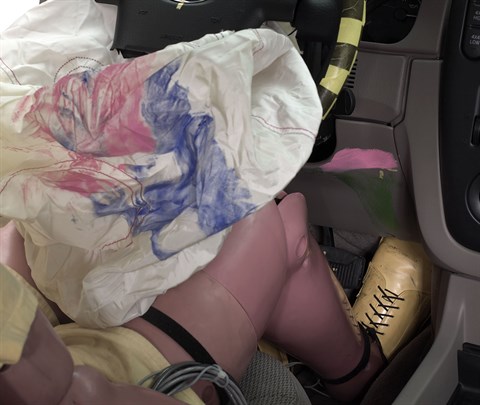Moderate overlap front: original test
Rating applies to 2002-05 models built after October 2001
Tested vehicle: 2002 Ford Explorer XLT 4-door 4wd
The Ford Explorer 4-door (except the Sport Trac model) and the Mercury Mountaineer were redesigned for the 2002 model year. Explorers and Mountaineers manufactured after October 2001 include structural changes to improve occupant protection in frontal offset crashes (note: information about when a specific vehicle was manufactured is on the certification label typically affixed to the car on or near the driver door).
The Insurance Institute for Highway Safety has evaluated the crashworthiness of a 2002 Explorer with the structural changes in a 40 mph frontal offset crash test into a deformable barrier.
The Explorer and Mountaineer have been re-engineered for the 2006 model year, and the Aviator has been dropped.
| Evaluation criteria | Rating |
|---|---|
| Overall evaluation | |
| Structure and safety cage | |
| Driver injury measures | |
| Head/neck | |
| Chest | |
| Leg/foot, left | |
| Leg/foot, right | |
| Driver restraints and dummy kinematics | |

Action shot taken during the frontal offset crash test.

The dummy's position in relation to the steering wheel and instrument panel after the crash test indicates that the driver's survival space was maintained well.

Smeared greasepaint shows where the dummy's head hit the roof rail, window frame, and B-pillar during rebound. Head accelerations from these hits were negligible.

Forces on the right lower leg were just high enough to indicate the possibility of injury.
Measures of occupant compartment intrusion on driver side
| Evaluation criteria | Measurement |
|---|---|
| Test ID | CEF0125 |
| Footwell intrusion | |
| Footrest (cm) | 13 |
| Left (cm) | 15 |
| Center (cm) | 18 |
| Right (cm) | 19 |
| Brake pedal (cm) | 10 |
| Instrument panel rearward movement | |
| Left (cm) | 3 |
| Right (cm) | 3 |
| Steering column movement | |
| Upward (cm) | 7 |
| Rearward (cm) | -6 |
| A-pillar rearward movement (cm) | 3 |
Driver injury measures
| Evaluation criteria | Measurement |
|---|---|
| Test ID | CEF0125 |
| Head | |
| HIC-15 | 202 |
| Peak gs at hard contact | negligible |
| Neck | |
| Tension (kN) | 1.9 |
| Extension bending moment (Nm) | 18 |
| Maximum Nij | 0.32 |
| Chest maximum compression (mm) | 35 |
| Legs | |
| Femur force - left (kN) | 7.0 |
| Femur force - right (kN) | 2.6 |
| Knee displacement - left (mm) | 3 |
| Knee displacement - right (mm) | 5 |
| Maximum tibia index - left | 0.53 |
| Maximum tibia index - right | 0.87 |
| Tibia axial force - left (kN) | 3.9 |
| Tibia axial force - right (kN) | 2.8 |
| Foot acceleration (g) | |
| Left | 101 |
| Right | 116 |
Head restraints & seats
Seat type: All seats
| Overall evaluation | |
|---|---|
| Dynamic rating | |
| Seat/head restraint geometry |
| Seat type | All seats |
|---|---|
| Geometry | |
| Backset (mm) | 92 |
| Distance below top of head (mm) | 82 |
| Seat design parameters | |
| Pass/fail | Fail |
| Max T1 acceleration (g) | 0.0 |
| Head contact time (ms) | |
| Force rating | 0 |
| Neck forces | |
| Max neck shear force (N) | |
| Max neck tension (N) | |
About the head restraint & seat test
Currently, IIHS tests apply only to front seats.